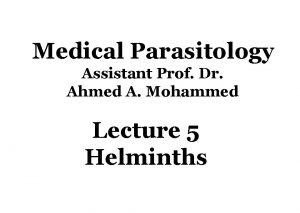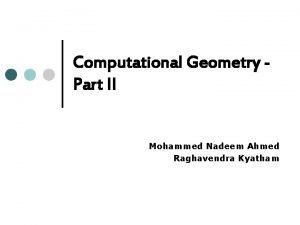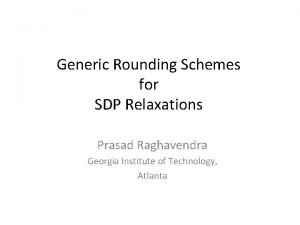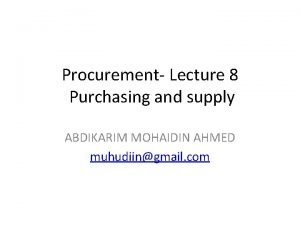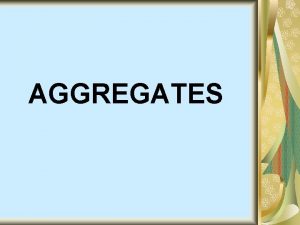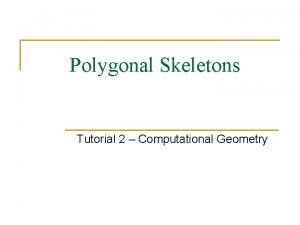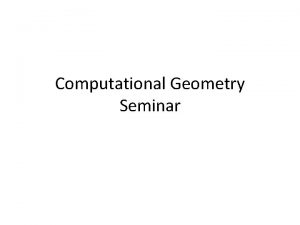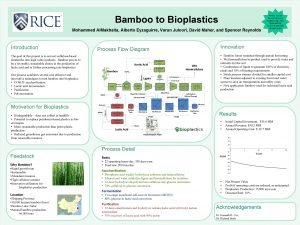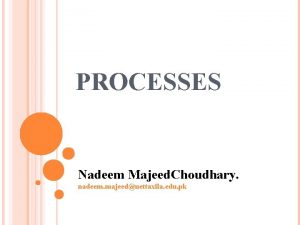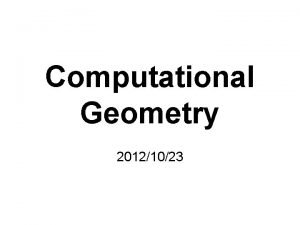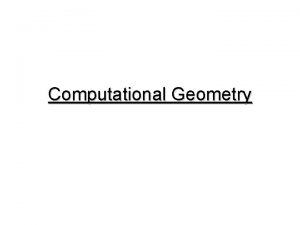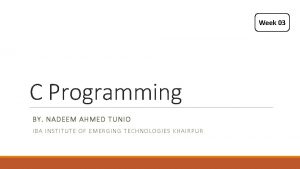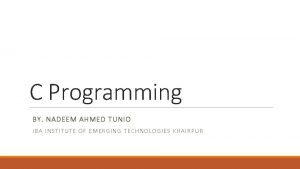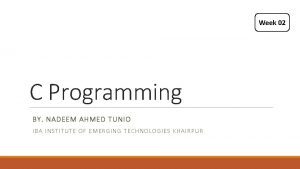Computational Geometry Part II Mohammed Nadeem Ahmed Raghavendra























- Slides: 23

Computational Geometry Part II Mohammed Nadeem Ahmed Raghavendra Kyatham

Table of Contents ¢ Convex Hull 1. 2. ¢ Jarvis’s March (Gift Wrapping Algorithm) Graham’s Scan Matrix Multiplication 1. 2. Strassen’s Multiplication Algorithm Analysis of Strassen’s

Convex Hull Definition: The Convex Hull of a set Q of points is the smallest convex polygon P, for which each point in Q is either on the boundary of P or in its interior. Intuition: If there is a plane Q , consisting of nails sticking out from a board. Then the Convex Hull of Q can be thought of the shape formed by a tight rubber band that surrounds all the nails.

Example of Convex Hull P 10 P 7 P 9 P 6 P 5 P 3 P 11 P 8 P 12 P 4 P 2 P 1 Po

Jarvis’s March ¢ Jarvis March computes the Convex Hull of a set Q of points by a technique called package wrapping or gift wrapping. ¢ Intuitively Jarvis March simulates a taut piece of paper around the set Q. To get the turning we take an “anchor” point then make a line with every other point and select the one with the least angle and keep on repeating. ¢ The algorithm runs in time O(nh) where h is the number of vertices

Example of Jarvis March’s algorithm starts from P 0 ie the anchor point. P 8 P 6 P 9 P 7 P 5 P 3 P 2 P 0 P 4 P 1 Then it wraps the next outer point and makes this as the new anchor point and repeats the procedure for the rest of the points……. Till every point is wrapped inside.

Graham’s Scan ¢ Graham Scan algorithm starts by taking the leftmost point. ¢ From this point calculate the angles to all other points ¢ Sort all the angles ¢ Start plotting to the next points ¢ Whenever it takes right turns it backtracks and re-joins those points that makes the shortest path.

Example: ¢ As shown, Grahams starts from a point (p 0) and calculates all the angles it makes to all the points and sorts the angles in an order

Example contd: ¢ It selects the point with the least angle and starts traversing (P 0 P 1). ¢ Then P 1 to P 2 & from P 2 to P 3 it realizes that it takes a right turn, so it backtracks and selects P 1 – P 3 directly, it being shorter

Example contd: ¢ The algorithm continues, based on the above mentioned conditions till it reaches back to the initial point. Hence forming the Convex Hull as shown:

Example contd:

Example contd:

Example contd: ¢ Once the initial point is reached the algorithm self terminates, and the Convex Hull is formed. ¢ The algorithm takes O(nlgn) i. e the time it takes to sort the angles.

Strassen’s algorithm ¢ The regular matrix multiplication algorithm takes O(n 3). ¢ But strassen’s algorithm uses dynamic programming to compute the matrix multiplication in O(n 2. 81).

Strassen’s explained: ¢ Suppose there are two matrices A and B giving the product matrix C. ¢ Then each matrix is divided into four sections as shown. A B C a b e f c d g h = r s t u

Strassen’s contd: C r s t u ¢ The product matrix C can be defined by the following equations: ¢ r=ae+bg s=af+bh t=ce+dg u=cf+df ¢ ¢ ¢

strassen’s contd: ¢ Each of the above entities in the previous equations take T(n/2) time. ¢ Since we have eight such multiplications it takes 8 T(n/2)+O(n 2), but strassen’s uses dynamic programming to reduce the number of multiplications to seven. ¢ Thus we have 7 T(n/2)+O(n 2).

Strassen’s explained: ¢ s= af+bh = af-ah+ah+bh = a(f-h) + h(a+b) p 1 p 2 s= p 1+p 2 p 1 takes T(n/2)+O(n 2) p 2 also takes T(n/2)+O(n 2).

Strassen’s contd: ¢ t= ce+dg = ce-de+de+dg = e(c-d) + d(e+g) p 3 p 4 t= p 3+p 4 p 3 takes T(n/2)+O(n 2) p 4 also takes T(n/2)+O(n 2).

Strassen’s contd: ¢ r= ae+bg p 5= (a+d) (e+h) = ae+ah+de+dh. p 5 computes the inessential terms ah and de, which need to be cancelled some how. We can use p 4 and p 2 to cancel them, but two other inessential terms appear so hence we use p 6 to cancel them. p 5 +p 4 -p 2= ae+dh+dg-bh And p 6 is given as (b-d) (g+h) P 6= bg+bh-dg-dh. Thus we obtain r= p 5+p 4 -p 2+p 6 = ae+bg. (hence achieved)

Strassen’s contd: ¢ Similarly we obtain ‘u’ from p 5 by using p 1 and p 3 to remove the inessential terms from p 5. ¢ We have p 5+p 1 -p 3 = ae+af-ce+dh and p 7 is given as p 7= (a-e) (e+f) = ae+af-ce-cf ¢ Leading us to u = p 5+p 1 -p 3 -p 7 = cf+dh

Strassen’s analysis ¢ Thus we computed only seven multiplications from p 1 p 7 using seven recursive calls. ¢ Thus T(n)= 7 T(n/2)+(n 2). ¢ Expanding: n 2(………(7/22)3 + (7/22)2 + 7/22 + 1) we have logn such terms that can be represented by the formula a. rn-1 - 1 r-1

Strassen’s contd: ¢ ¢ Using the above formula we can simplify the series to (7/4)logn + O(n 2) This can also be represented as: = nlog 7/4 + O(n 2) = nlog 7 -log 4 + O(n 2) = nlog 7 -2 + O(n 2) = nlog 7/n 2 + O(n 2) = n 2 (nlog 7/n 2) = nlog 7 Thus we get the complexity O(nlog 7) = O(n 2. 81).
 Dr mohammed ahmed
Dr mohammed ahmed Dr mohammed ahmed
Dr mohammed ahmed Ahmed mohammed security
Ahmed mohammed security Prasad raghavendra
Prasad raghavendra Ahmed muhudiin ahmed
Ahmed muhudiin ahmed Nadeem asghar
Nadeem asghar Rana nadeem
Rana nadeem Straight skeleton algorithm
Straight skeleton algorithm Computational geometry
Computational geometry The basis of the vsepr model of molecular bonding is
The basis of the vsepr model of molecular bonding is Lewis structures and molecular geometry
Lewis structures and molecular geometry 4 electron domains 2 lone pairs
4 electron domains 2 lone pairs Source
Source Mohammed bamboo
Mohammed bamboo Meromyosin
Meromyosin Mohammed mona md
Mohammed mona md Mohammed el husseiny
Mohammed el husseiny Mohammed aledhari
Mohammed aledhari Gedicht prophet mohammed
Gedicht prophet mohammed Professor mohammed arif
Professor mohammed arif Ksu.edu.tw
Ksu.edu.tw Emaptic
Emaptic Dr samah mohammed
Dr samah mohammed Dr reshma mohammed
Dr reshma mohammed
